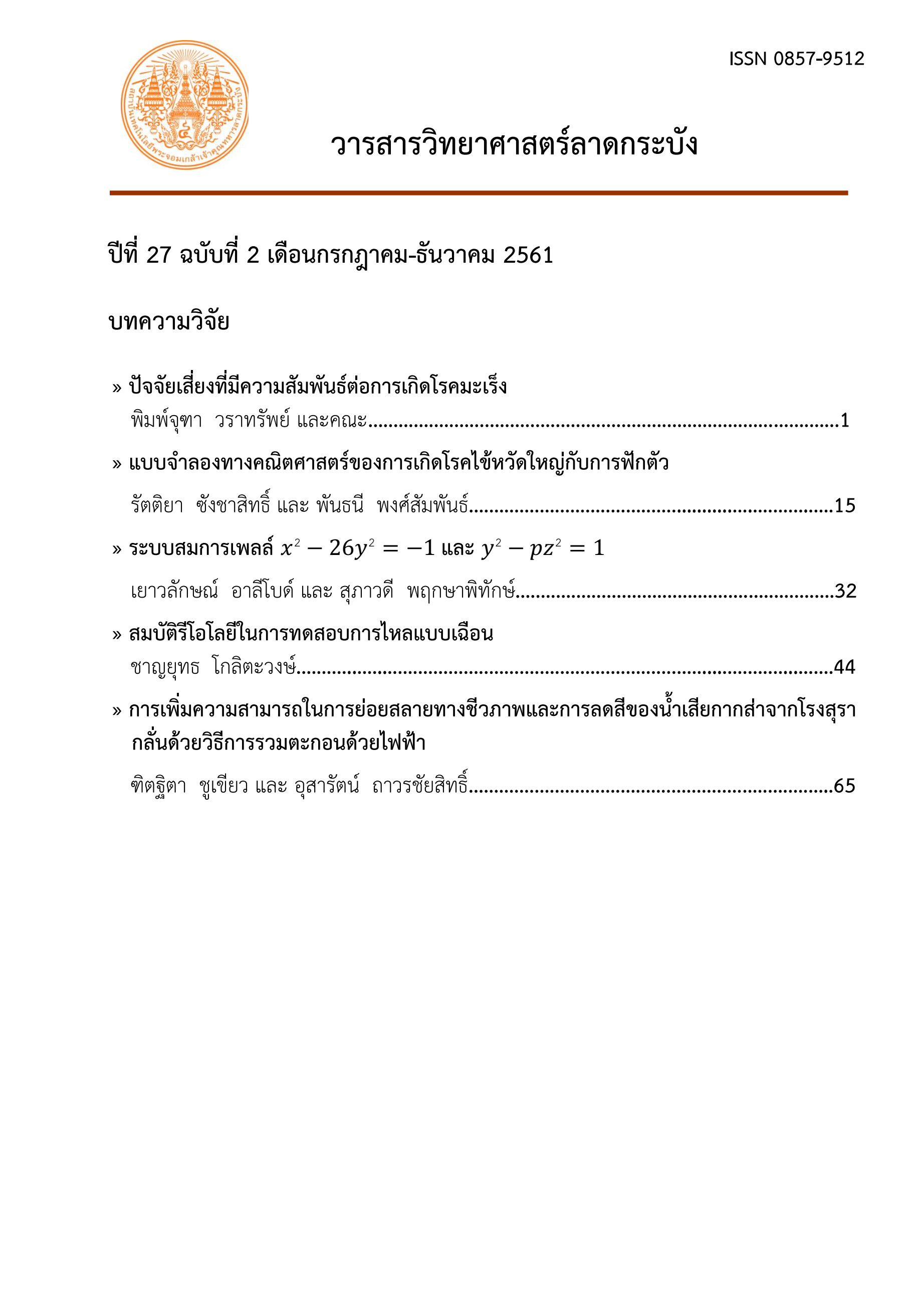Biodegradability Enhancement and Decolorization of Molasses-based Wastewater from Distilleries by Electrocoagulation
Main Article Content
บทคัดย่อ
ลักษณะสำคัญของน้ำเสียจากการผลิตสุรากลั่นที่ใช้กากน้ำตาลเป็นวัตถุดิบคือมีสารอินทรีย์เจือปนในปริมาณสูง โดยสารประกอบอินทรีย์บางชนิดมีสมบัติที่ยากต่อการย่อยสลายทางชีวภาพ และมีสีน้ำตาลเข้มจนถึงเกือบดำ งานวิจัยนี้จัดทำขึ้นเพื่อศึกษาความเป็นไปได้ในการใช้วิธีการรวมตะกอนทางไฟฟ้า (EC) เป็นวิธีการบำบัดเบื้องต้นเพื่อเพิ่มดัชนีการย่อยสลายทางชีวภาพเละลดสีของน้ำกากส่า ทำการทดลองในถังปฏิกิริยาแบบแบทช์โดยใช้อะลูมิเนียมเป็นขั้วอิเล็กโทรด พร้อมกับศึกษาผลของตัวแปรอิสระต่อการเพิ่มขึ้นของดัชนีการย่อยสลายทางชีวภาพ (BI: อัตราส่วนบีโอดี 5 วันต่อซีโอดี) และประสิทธิภาพในการกำจัดสีของน้ำกากส่า โดยปัจจัยที่ทำการศึกษาได้แก่ ระยะเวลาในการทำปฏิกิริยา ความต่างศักย์ไฟฟ้า เละพีเอชของน้ำ ผลการศึกษาพบว่า อัตราส่วนของ บีโอดี 5 วันต่อซีโอดี (BOD5:COD) ในน้ำกากส่ามีค่าเพิ่มขึ้นจาก 0.15 เป็น 0.47 เมื่อจ่ายความต่างศักย์ไฟฟ้าที่ 5 โวลต์ ให้กับตัวอย่างน้ำกากส่าที่มีพีเอชเริ่มต้นเท่ากับ 6 เป็นเวลา 90 นาที ที่สภาวะดังกล่าว วิธีการรวมตะกอนทางไฟฟ้าสามารถลดสีของน้ำกากส่า จากค่าเริ่มต้นที่ 256,203 ADMI เหลือ 163,009 ADMI คิดเป็นประสิทธิภาพการกำจัดสีเท่ากับ 36.4 เปอร์เซนต์
Article Details
เอกสารอ้างอิง
[2] ไชยยุทธ กลิ่นสุคนธ์. 2524. โครงการก่อสร้างสุราใหม่. สถาบันวิจัยวิทยาศาสตร์และเทคโนโลยีแห่งประเทศไทย (สวท.). แหล่งข้อมูล : https://www2.diw.go.th/sura/ปนเปื้อน/chapter2.doc. ค้นเมื่อวันที่ 20 ตุลาคม 2560.
[3] ชวลิต รัตนธรรมสกุล และภาศัลย์ ใจรังษี. 2548. รายงานการวิจัยฉบับสมบูรณ์: การวิจัยและพัฒนากระบวนการเมมเบรนในถังปฏิกรณ์ชีวภาพสำหรับบำบัดน้ำเสียจากโรงงานสุรา. กองทุนเพื่อลดผลกระทบจากนโยบายสุราเสรีของรัฐ. แหล่งข้อมูล : https:// www2.diw.go.th/sura/นโยบายสุราเสรีของรัฐ/DIW/chapter%201.doc. ค้นเมื่อวันที่ 19 พฤษภาคม 2560.
[4] Kharayat, Y. 2012. Distillery wastewater: Bioremediation approaches. Journal of Integrative Environmental Sciences. 9, 69-91.
[5] Abdallaa, K.Z and Hammamb, G. 2014. Correlation between biochemical oxygen demand and chemical oxygen demand for various wastewater treatment plants in Egypt to obtain the biodegradability indices. International Journal of Sciences: Basic and Applied Research, 13(1), 42-48.
[6] Kumar, V., Wati, L., FitzGibbon, F., Nigam, P., Banat, I.M., Singh, D. and Marchant, R. 1997. Bioremediation and decolorization of anaerobically digested distillery spent wash. Biotechnology Letters, 19(4), 311–314.
[7] สมพงษ์ หิรัญมาศสุวรรณ. 2551. กระบวนการโคแอกกูเลชั่นด้วยไฟฟ้า. วารสารเทคนิค เครื่องกล ไฟฟ้า อุตสาหการ, 283, 138-144. [Somphong Hiranmasuwan. 2008. Electrocoagulation process. Technic-Magazin, 283, 138-144. (in Thai)]
[8] พรศักดิ์ สมรไกรสรกิจ. 2556. กระบวนการโคแอคกลูเลชั่นและฟล็อคกลูเลชั่น. การประปานครหลวง. แหล่งข้อมูล : https://www.mwa.co.th/ewt_dl_link.php?nid=441. ค้นเมื่อวันที่ 26 ธันวาคม 2559.
[9] Asha, A., Keerthi, MuthukrishnarajN A. and Balasubramanian, N. 2014. Improvement of biodegradability index through electrocoagulation and advanced oxidation process. International Journal of Industrial Chemistry, 5: 4. https://doi.org/10.1007/s40090-014-0004-x.
[10] Hanafia, F., Belaoufia, A., Mountadarb, M. and Assobhei, O. 2011. Augmentation of biodegradability of olive mill wastewater by electrochemical pre-treatment: Effect on phytotoxicity and operating cost. Journal of Hazardous Materials, 190, 94-99.
[11] Phalakornkulea, C., Mangmeemak, J., Intrachod, K. and Nuntakumjorna, B. 2010. Pretreatment of palm oil mill effluent by electrocoagulation and coagulation. ScienceAsia, 36, 142-149.
[12] Arslan-Alaton, I. and Turkoglu, G. 2008. Treatability of a simulated spent disperse dyebath by chemical and electrochemical processes. Environmental Engineering Science, 25(3), 295-308.
[13] Sontaya, K., Pitiyont, B. and Punsuvon, V. 2013. Decolorization and COD removal of palm oil mill wastewater by electrocoagulation. International Journal of Environmental and Ecological Engineering, 7(9). 606-609.
[14] American Public Health Association, American Water Works Association and Water Environment Federation (APHA, AWWA and WEF). 2005. Standard Methods for the Examination of Water and Wastewater. 21st ed., APHA, AWWA and WEF, Washington, DC.
[15] Kobya, M. and Gengec, E. 2012. Decolourization of melanoidins by a electrocoagulation process using aluminium electrodes. Environmental Technology, 33(19-21), 2429-2438.
[16] David, C., Arivazhagan, M. and Tuvakara, F. 2015. Decolorization of distillery spent wash effluent by electro oxidation (EC and EF) and Fenton processes: A comparative study. Ecotoxicology and Environmental Safety, 121:142-148.
[17] Bazrafshan, E., Moein, H., Ferdos, K.M. and Nakhaie, S. 2013. Application of electrocoagulation process for dairy wastewater treatment. Journal of Chemistry, Article ID 640139. https://dx.doi.org/10.1155/2013/640139
[18] Godini, K., Azarian, G., Nematollahi, D., Rahmani, A.R. and Zolghadrnasab, H. 2012. Electrochemical treatment of poultry slaughterhouse wastewater using iron and aluminium electrodes. Research Journal of Chemistry and Environment, 16(3), 98-103.
[19] Carrier, X., Marceau, E., Lambert, J.-F., Che, M., 2007. Transformations of -alumina in aqueous suspensions: 1. Alumina chemical weathering studied as a function of pH. Journal of Colloid and Interface Science, 308 (2), 429-437.
[20] Khemis, M., Leclerc, J.-P., Tanguy, G., Valentin, G., Lapicque, F., 2006. Treatment of industrial liquid wastes by electrocoagulation: Experimental investigations and an overall interpretation model. Chemical Engineering Science, 61 (11), 3602-3609.
[21] Tezcan Un, U., Koparal, A.S., Bakir Ogutveren, U., 2009. Electrocoagulation of vegetable oil refinery wastewater using aluminum electrodes. Journal of Environmental Management, 90, 428-433.

